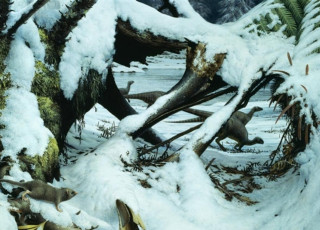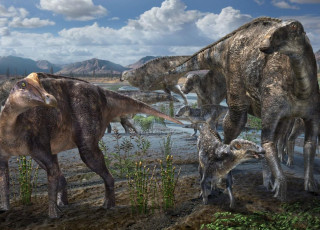Polar Dinofest: Pat Druckenmiller
By Riley Black
Did Alaska's polar dinosaurs stay in the same habitats year-round, or did they migrate? Paleontologists have been wondering about this question for years, trying to understand how the "terrible lizards" would have coped with the harsh habitats of the ancient Arctic. Recent finds along Alaska's Colville River, says University of Alaska paleontologist Pat Druckenmiller, have provided some critical clues for answering these questions.
"The dinosaurs that were preserved in the Prince Creek Formation lived very, very far north," Druckenmiller notes. The environment would have been a little warmer than today, but still would have been comparatively chilly and still experienced four months of darkness caused by the Earth's tilt relative to the sun. These were the northernmost habitats for non-avian dinosaurs, very different from the lush, swampy habitats we often think of dinosaurs inhabiting.
Paleontologists have found plenty of large dinosaurs, but there's more to the fossil record than giants. "Some of the most exciting discoveries we're making in Alaska involve some of the smallest teeth and bones ever found in North America," Druckenmiller says. So far, experts have found very young dinosaurs from at least seven different dinosaur species. It's a spectacular spread, covering many of the dinosaur species found in these rocks.
These little fossils have big implications. Juvenile dinosaurs found in Alaska indicate that dinosaur species were nesting and reproducing in these habitats, meaning that they probably did not travel long distances to follow the seasons. Even better, some of these fossils indicate that particular dinosaur species never before seen in the Arctic were present in these habitats. Finding babies, which would have been unable to make trips far enough to escape the dark winter months, indicates that Alaska's Cretaceous dinosaurs stayed put. "We believe these dinosaurs were year-round residents of the polar latitudes," Druckenmiller says, which will only lead to more questions about what life was like for dinosaurs of the Cretaceous Arctic.
Click Here to Explore More of NHMU's Polar DinoFest
Riley Black is the author of Skeleton Keys, My Beloved Brontosaurus, Prehistoric Predators, and a science writer for the Natural History Museum of Utah, a part of the University of Utah in Salt Lake City. Our mission is to illuminate the natural world and the place of humans within it. In addition to housing outstanding exhibits for the public, NHMU is a research museum. Learn more.



